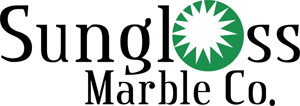Commercial Marble and Granite Restoration – What Exactly is Wet Grinding?
Being in the business of commercial marble, granite, limestone and terrazzo restoration in lobbies, reception areas, and the like, we at Sungloss Marble Restoration use a process called ‘wet grinding’ often. However, not all our clients would be able to accurately describe that process, or its’ parameters.
Simply speaking, wet grinding stone is akin to sanding a wood floor. The stone is ground by pads of industrially produced (man made) diamonds, filtered in the same way grits of sand are filtered for sandpaper. The pads are affixed underneath a machine designed to evenly apply rotation and pressure on the floor, and supply a small amount of water during the grinding process. This is the difference between sanding a wood floor and wet grinding a stone floor – the water traps the stone dust and leaves it suspended in the water for easy squeegeeing or wet vacuuming.
The thickness of scratches is relative in the eyes of the beholder, but we can tell you some basics about scratch removal. In softer stones (almost all but granite) fine scratches develop over time with foot traffic (debris or sand tracked in), vacuum cleaners, wheeled equipment, etc. A moderately significant scratch would be one you can actually feel with you fingernail. Anything deeper than the thickness of a business card is considered a ‘deep’ scratch.
When a floor is ground to specifically remove scratches, removing the thickness of a business card (approximately .012 to .014 inches) is not harmful to the integrity of the surface, nor is it noticeable height-wise. When deeper scratches are a problem, there is a limit to grinding, when the structural integrity of the stone can become affected, or the area with the scratch will actually be noticeable lower (ground down) than the surrounding tiles or stone.
Lippage is a term describing the phenomenon when a tile edge is crooked or uneven, and does not line up flat with the adjacent tiles. This can be remedied by grinding too, although it is usually harder to remove than scratches. The severity and individual configuration of each affected area needs a talented professional’s hand to grind the tiles (not too little or too much), to blend edges in hopes of achieving the most uniformly ‘flat’ floor possible. This process is frequently done with heavy rotary machines as well as handheld machines, or even handheld diamond pads for fine work. We’ve seen the whole spectrum of lippage (from hardly any to a disaster) and the final results will be on a spectrum as well. Some lippage may still remain, but the overall impression is more uniform than before…it all depends on the severity of the problem.
When it comes to scratch removal or lippage removal, our commercial clients including banks, hotels, developers, construction companies, and designers to name a few, have seen first hand how Sungloss adds quality to their commercial stone environment through restoration.
